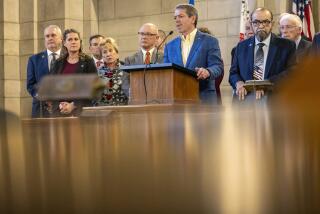Dining a la Food Stamps Is Catching On
LEWISTON, Me. — For Angelina LeClair, being able to use food stamps in certain restaurants means a hot breakfast--a blueberry muffin, bacon and coffee--in the cafeteria adjoining the housing complex where she lives.
“I’m there every morning,” said LeClair, 69, who is among the 128 elderly or disabled residents of the Marcotte Congregate Housing center in Maine’s second-largest city.
Across the Androscoggin River in Auburn, in one of the textile and shoe factories that have been converted into subsidized housing, Ruth Trosper says even the $10 a month in food stamps that she receives is enough to eat out occasionally at a small restaurant down the street.
“I can have my breakfast down to the diner, where otherwise I couldn’t afford it,” said Trosper, 74.
Maine is one of the most recent states to sign up for the U.S. Department of Agriculture’s food stamps-in-restaurants program, which has existed in some form for 20 years but remains unused by most states.
Participation is limited to food-stamp recipients who are at least 60 or their spouses, disabled people who receive Supplemental Security Income and the homeless. Maine restaurants cannot be certified for the program unless nearly all of the meals they offer can be purchased for less than $5, including a beverage. The restaurant rules vary from state to state.
The program presents “another opportunity for a warm meal” for people who otherwise might go without, said Peter McCarron, food stamp director for the Maine Department of Human Services.
But, nationally, only 16 other states allow food-stamp recipients to use the coupons in restaurants, according to the USDA’s Food and Nutrition Service, which administers the food stamp program.
Even in many states that do participate, finding restaurants that accept food stamps may be next to impossible. Fewer than 200 restaurants around the country accepted food stamps as of last fall, the most recent figures available, and half of those were located in New York state.
Wendy Webster of the National Restaurant Assn. in Washington said the program has not been publicized enough but said that restaurateurs also may have reasons for not wanting to participate, such as adding to their paperwork burden.
Philip Shanholtzer, a spokesman for the Food and Nutrition Service in Alexandria, Va., said it is up to the states to take the lead.
“The program is there, and the states know that,” Shanholtzer said. “There really aren’t a lot of resources for going out and promoting it.”
Ironically, Maine officials initially applied for the program because they thought the federal government required it. When they learned it was optional, they decided to press ahead anyway because it seemed like a good idea.
The federal government spends about $27 billion a year providing food stamps for nearly 27 million Americans. The benefit varies based on income--up to $112 a month for a single person--and averages $68 a month.
Although Maine has been in the restaurant program for only a couple of months, it already is among the most active participants.
About 20,000 households are eligible for the program, out of the 63,000 that receive food stamps, with senior citizens making up the vast majority of those who qualify, McCarron said.
At the New Auburn Diner, where Trosper likes to eat breakfast, co-owner Louise Giguere said she serves no more than a half-dozen people who use food stamps even in a busy week--not enough to make much difference in her bottom line. But she thinks older people appreciate the new program.
More to Read
Sign up for Essential California
The most important California stories and recommendations in your inbox every morning.
You may occasionally receive promotional content from the Los Angeles Times.










